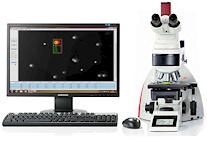Reference cells and mixed-ploidy cells in the comet assay
- Details
- Created: Tuesday, 07 June 2016 07:13
Scientists at the University of Oslo and Norwegian Institute of Public Health (both based in Oslo, Norway) have been investigating the use of “reference cells” within the comet assay. They also performed the comet assay on a mixture of testicular cells with various ploidy.
In the comet assay, single cells are analysed with respect to their level of DNA damage. The researchers involved with this investigation believe discrimination of the individual cell, or cell type, by concomitant scoring of the DNA damage is useful since this may allow analysis of cell mixtures. Different cells within a mixture can then be characterised based on their ploidy, cell cycle stage, or genome size.
The scientists used this publication to describe two applications of such a cell-type-specific comet assay:
(i) Testicular cell suspensions, analysed on the basis of their ploidy during spermatogenesis; and
(ii) Reference cells in the form of fish erythrocytes which can be included as internal standards to correct for inter-assay variations.
 For scoring of fish erythrocytes and human peripheral blood mononuclear cells comets, dried GelBond films(please refer to our case study on this technique) were rehydrated and stained with SYBRGold, rinsed in water, and analysed with Comet Assay IV (Perceptive Instruments Ltd, Bury St. Edmunds, UK). An Olympus BX51 fluorescence microscope with CCD camera was used. Tail % DNA and Total Fluorescence Intensity were recorded for each cell; these parameters are already integrated in Comet Assay IV. During scoring no cells were excluded on the basis of either a very strong or a very weak fluorescent signal.
For scoring of fish erythrocytes and human peripheral blood mononuclear cells comets, dried GelBond films(please refer to our case study on this technique) were rehydrated and stained with SYBRGold, rinsed in water, and analysed with Comet Assay IV (Perceptive Instruments Ltd, Bury St. Edmunds, UK). An Olympus BX51 fluorescence microscope with CCD camera was used. Tail % DNA and Total Fluorescence Intensity were recorded for each cell; these parameters are already integrated in Comet Assay IV. During scoring no cells were excluded on the basis of either a very strong or a very weak fluorescent signal.
The researchers concluded: “With standard fluorochromes used in the comet assay, the total staining signal from each cell – whether damaged or undamaged – was found to be associated with the cell’s DNA content.”
Analysis of the fluorescence intensity of single cells is straightforward since these data are available within Comet Assay IV.
The scientists concluded that:
- the analysis of testicular cell suspensions provides information on cell type specific composition, susceptibility to genotoxicants, and DNA repair.
- and internal reference cells, either untreated or carrying defined numbers of lesions induced by ionizing radiation, are useful for investigation of experimental factors that can cause variation in comet assay results, and for routine inclusion in experiments to facilitate standardisation of methods, and comparison of comet assay data obtained in different experiments or in different laboratories. They can also be used – in combination with a reference curve – to quantify the DNA lesions induced by a certain treatment. The researchers recommended that fish cells (of a range of genome sizes -both greater and smaller than human) are suitable for this purpose, and they are inexpensive.
For more information, please refer to the original publication:
Reference cells and ploidy in the comet assay.
Brunborg G, Collins A, Graupner A, Gutzkow KB, Olsen AK.
Front. Genet., 27 February 2015 27;6:61.
